
25 Unusual Death Rituals from Around the World
Death is inevitable yet is one of the most feared things in the entire world. Everyone dies at some point and here’s no escaping it’s grasp.
What really happens when you die? That’s definitely one of the eternal questions we are constantly asking ourselves.
Funerary rites, like death, are a source of fascination tinged by mystery and fear. Closely related to how we view the afterlife and how we relate to one another, these rites touch on something fundamental to human nature.
Some don’t simply accept that someone has lived and died, but their life is truly celebrated. And some people, the way they grieve, commemorate, and dispose of dead varies greatly from culture to culture, but some traditions really take funerals to the next level of macabre.
Those of you who think burial and cremation are the only death rituals; please prepare yourself before you read what follows below:
1. Tibetan Buddhist Celestial Burials
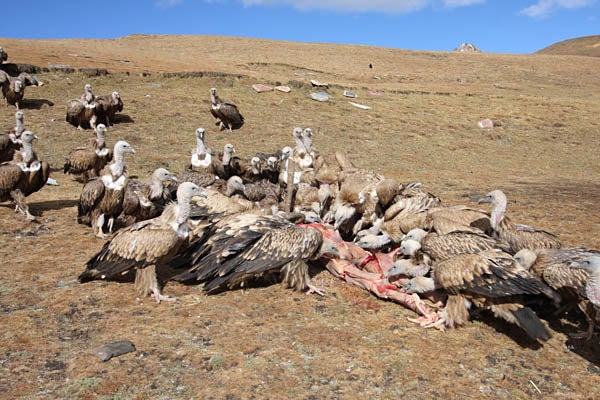
Tibet’s harsh climate and stony ground makes burial a near-impossible task. So, Tibetan Buddhists practice ritual dissection, or “Sky Burials” — the tradition of chopping up the dead into small pieces and giving the remains to animals, particularly birds. Sometimes the body is left intact — which is not a problem for advantageous vultures. In Buddhism, a dead body is seen as an empty vessel and is not commemorated.
2. Sati

Sati (also called suttee) was a funerary practice among some Hindu communities in which recently widowed women immolated themselves on their husband’s funeral pyre. The practice of sati was considered to be religious in the history of India. The custom was seen as a voluntary act, but there were many instances in which women were forced to commit Sati — sometimes even dragged against their will to the fire. However other forms of sati exist, including being buried alive with the husband’s corpse and drowning.
Although the practice is outlawed and illegal in today’s India, yet it occurs up to the present day and is still regarded by some Hindus as the ultimate form of womanly devotion and sacrifice.
One reason why sati started is that it was introduced to prevent wives from killing their wealthy husbands (typically with poison) and marry their real lovers. Another possibility is that it was seen as a way for a husband and wife to enter into the afterlife together so that they could thwart opportunistic female angels.
The term Sati is derived from the original name of the goddess Sati, also known as Dakshayani, who self-immolated because she was unable to bear her father Daksha’s humiliation of her (living) husband Shiva. Sati as practice is first mentioned in 510 CCE, when a stele commemorating such an incident was erected at Eran, an ancient city in the modern state of Madhya Pradesh. The custom began to grow in popularity as evidenced by the number of stones placed to commemorate satis, particularly in southern India and amongst the higher castes of Indian society, despite the fact that the Brahmins originally condemned the practice (Auboyer 2002).
Interestingly, India was not the first and only culture to adopt the tradition. Other ancient societies that practiced something similar to Sati included the Egyptians, Greeks, Goths, and Scythians.
3. Self-Mummification

Practiced seemingly exclusively by Japanese Sokushinbutsu Buddhist monks, the rite of self-mummification was intended as a means of demonstrating dedication and spirituality. Priests would essentially commit suicide over an extended period of time, beginning with the ingestion over 1000 days of a nut and seed diet intended to rid their body of all its fat. They would then eat bark and drink poisonous tea over another 1000 days in order to make their body so poisonous that maggots would not infest it after the monk’s death. This tea drinking did, however, have the unfortunate side-effect of causing vomiting and massive fluid loss. The final part of the process would see the monk take up their final residence within a sealed stone tomb, containing nothing but an air tube and small bell, which would be rung once each day to let those outside know that they were alive. Once the bell stopped ringing, the tomb would be sealed for a further 1000 days before the mummified priest was removed and put on display in the monastery.
4. Endocannibalism

Endocannibalism is the ugly custom where people from certain tribes eat up the flesh of their dead as a funerary rite! Those who perform this cannibalistic custom do so as a method of veneration of the dead or to gain certain good qualities of the deceased such as wisdom, etc. The idea behind the horrid custom could be anything; from imbibing the deceased’s traits to assimilation of the spirit. A few tribes in South America and Australia are said to have practiced this creepy ritual. But many academics feel that endocannibalism is a false accusation thrown at tribes by early colonists to gain an excuse for political domination. According to anthropologist Napolean Changon, the Yanomamo community in South America still eats the ash and ground bones of the deceased after cremation.

The Yanomami are an indigenous people of South America.
The Yanomamo tribes of Venezuela and Brazil practiced endocannibalism by mixing the ashes of the deceased with a plantain soup and then drinking it.
The Fore people of Papua New Guinea were quite well known for their endocannibalism, in which women and children played a major role. A woman of the tribe could eat the brain of a deceased brother, the hands of her brother-in-law and the vulva, bowels and buttocks of her dead sister-in-law.
In the above instances, endocannibalism was practiced as a form of anthropophagy(cannibalism). But certain cultures which didn’t practice anthropophagy were also known to practice endocannibalism:
The chief tribesman of the West-African Junkun tribe eats the hearts of his predecessors, as a way of placing himself away from the normal society which he administers.
The Nigerian Rukuba chiefs would devour the flesh of an infant from their tribe (how diabolic!).
The Wari tribes of the Amazon practiced endocannibalism for two reasons. First, this was a funerary rite for converting the deceased from humans to spirits and secondly, it was done to counter the grief of having lost a dear one by consuming his flesh and getting rid of his possessions.
Thus, many uncivilized tribes were known to practice this act within their communities. Today it has ceased in most places, but may continue in certain remote parts.
5. LifeGem

A dazzling death!! People can now wear their loved ones on their fingers. To create the shiny crystal, this American company called LifeGem takes a person’s cremated remains, turns them into graphite, then places it into a diamond press. For $3500 to $20,000, you can wear your loved one on your finger.
6. The Viking Funeral
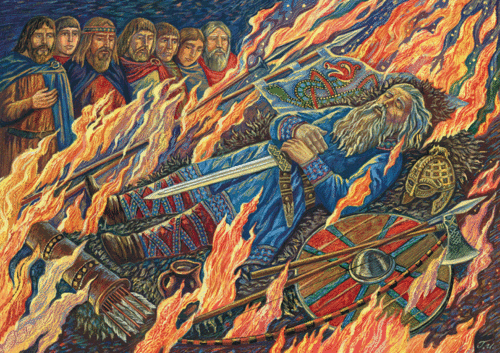
Hindi women clearly had it tough — but so did the slave girls of Viking noblemen. According to the historic account of Ahmad ibn Fadlan, a 10th century Arab Muslim writer, the ritual following the death of a chieftain was exceptionally brutal. Once dead, a chieftain’s body was put into a temporary grave for ten days while new clothes were being prepared for him. During this time, one of his slave girls would “volunteer” to join him in the afterlife; she was then guarded day and night and given copious amounts of intoxicating drinks. Once the cremation ceremony got started, the girl went from tent to tent to have sex with every man in the village. As the men were having sex with her — or what today we woud call “rape” — they would say, “Tell your master that I did this because of my love for him.” Following this, the girl was taken to a tent where she had sex with six Viking men, was strangled to death with rope, and finally stabbed by a village matriarch. And for the coup de grace, the bodies of the chieftain and slave girl were place onboard a wooden ship that was set alight. The Vikings did this to ensure that the slave girl would serve her master in the afterlife, while the sexual rites were a way to transform the chieftain’s life force.
7. Ritual Finger Amputation
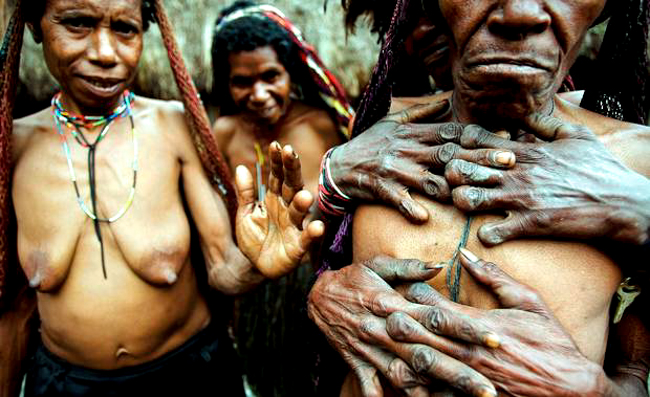
In West Papua, New Guinea, when a loved one passed on, the Dani people used to cut off their own fingers. When the eldest male of the house dies any women and children related to the deceased had to cut off fingers. They would tie them together and then cut them off with an axe.
The Tradition
Before amputation, they will tie a string tightly around the upper half of their finger for 30 minutes, allowing it to go numb for a (near) painless removal. Often it is a close family member—sibling or parent—who cuts the finger. After removal, the open sores are cauterized, both to prevent bleeding and in order to form new-callused fingertips.
Finger cutting is said to be symbolic of the pain suffered after losing a loved one. They cut off their fingers because they believed it would please and chase away the spirits. Also it provided physical pain as a way to mourn
Beliefs
This ritual is now banned, but was allegedly practiced to drive away spirits as well as to use physical pain as a form of expression.
The amputated flesh was then dried and burned to ashes or stored in a sacred place.
8. Funeral Strippers
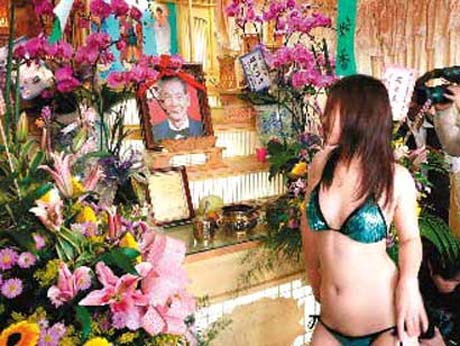
Taiwan showgirls are known to strip for the dead during religious events in order to “appease the wandering spirits. The Taiwanese phenomenon is labelled by some as scandalous, but many hail it as an important part of the grieving process – and the perfect way of sending off their loved ones with a smile.

China: Crackdown on funeral strippers used to attract mourners
In China’s Donghai region, funerals are actually status symbols. A dead man’s reputation and honor is considered to be directly proportional to the number of people who attend his funeral. So, the relatives hire strippers to pull the crowds. The Chinese authorities have started cracking down on the practice after incessant media glare.
9. Famadihana – Turning of the Bones

Famadihana, or “Turning of the Bones,” the ritual has been around for three centuries — one that the local Christian churches are doing their best to stamp out.
The celebration is often held once every five or seven years and is a time of joyous family reunions. The Malagasy people of Madagascar have a centuries-old celebration for the dead by exhuming the bodies and dressing them in new clothes or cloth. The spirit of the deceased joins the ancestors after the body has decomposed. Then, the Malagasy dance with the corpses around the tomb to live music.
10. Tana Toraja in Eastern Indonesia

Funerals in Tana Toraja, in eastern Indonesia, are epic affairs that involve an entire village and can last anywhere from a couple days to weeks. The burial ceremony is accompanied by music, dance and a feast for a number of guests. Understandably, death here is an extravagant occasion with a huge price tag. So, the relatives of the deceased are given a reprieve. Sacrificial water buffalo are slaughtered to carry the soul of the deceased into the afterlife. But that moment could take years. In the meantime, they are considered one “who is asleep” or a “sick man” and are placed in special rooms within the home and symbolically fed, included in the daily routines and conversations, cared for and taken out–remaining a part of their relative’s lives. An actual burial takes place when the family is prepared for it and the coffin is placed in a grave, cave or hung on a cliff.


The Torajans don’t consider physical death the end of the line. Instead, death is considered only part of the gradual process toward “Puya,” or the Land of Souls.
Though the Torajans are considered predominantly Christian, they hold on to a large part of their ancestors’ animist belief system—especially when it comes to death and dying.
Torajan death ritual, “tomb sweeping,” taken to a morbid extreme. Depending on the village, every one to five years, families reunite to exhume the bodies of their deceased relatives, clean up the inside of their coffins, and, if the mummified bodies are in solid enough condition, give their ancestors a fresh change of clothes.
11. Santhara or Fasting to Death
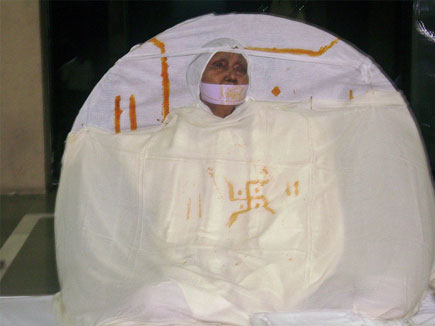
Santhara is a voluntary death brought on by fasting which a community believes in non-violence towards all creatures. Practiced by the Jains community in India, Santhara begins after a person decides their life has served its purpose and they are ready for spiritual purification. This practice is often seen as a form of suicide or euthanasia. There is growing opposition to the ritual, which is often seen as a form of suicide or euthanasia. But within the community, preventing santhara can invite ostracism.
12. Fantasy Coffins

In Ghana, the death of a loved one is a time to mourn for them as well as a time to celebrate their life. Instead of being buried in a traditional coffin, carpenters fashion out caskets symbolizing the deceased person’s life, including their character traits or status in society. Some are quite creative and made into fish, coke bottles, animals, or beer cans.
13. Zoroastrian Funeral- Tower of Silence”

The Zoroastrians in Mumbai, India, would leave their dead at a “dakhma,” also known as “Tower of Silence.” Zoroastrians believe that after death the body becomes a host for corruption and defilement. The scripture and tradition spoke of decaying corpses polluting the earth. Cremation or burial are ruled out because they might end up polluting sacred elements like fire and earth. So, they go for a ritual called exposure of the dead and their exposed bodies were taken to “Tower of Silence” to be eaten by vultures.
A body being prepared for Sky burial in Sichuan.
The funeral gets off to a rousing start by having the corpse cleansed in unconsecrated bull’s urine (which can only be done by a specially trained member of the community). Once “clean,” the corpse is laid in linen and visited twice by the “Sagdid” — a dog that can cast away evil spirits. After mourners visit the corpse (touching is strictly forbidden), it is placed on top of the Dhakma, or “Tower of Silence,” where the Zoroastrians remove the clothes using tools (the clothes are later disposed of as they’ve been defiled). Following this, the body is quickly devoured by vultures. The entire ritual is done in this way to ensure the minimal amount of harm and injury to the living.
Dead by leaving the corpses in uncovered Towers of Silence was discontinued in Iran in the 1960s.
14. Deads before burning, Varanasi, India
On the banks of the Ganges River, Hindus bathe in the waters to absolve them of their sins. The Ganges is also a place encompassed in death. Believing that the river will release them from the cycle of rebirth, wealthy Hindus are ceremoniously cremated here and their ashes are released into the water.
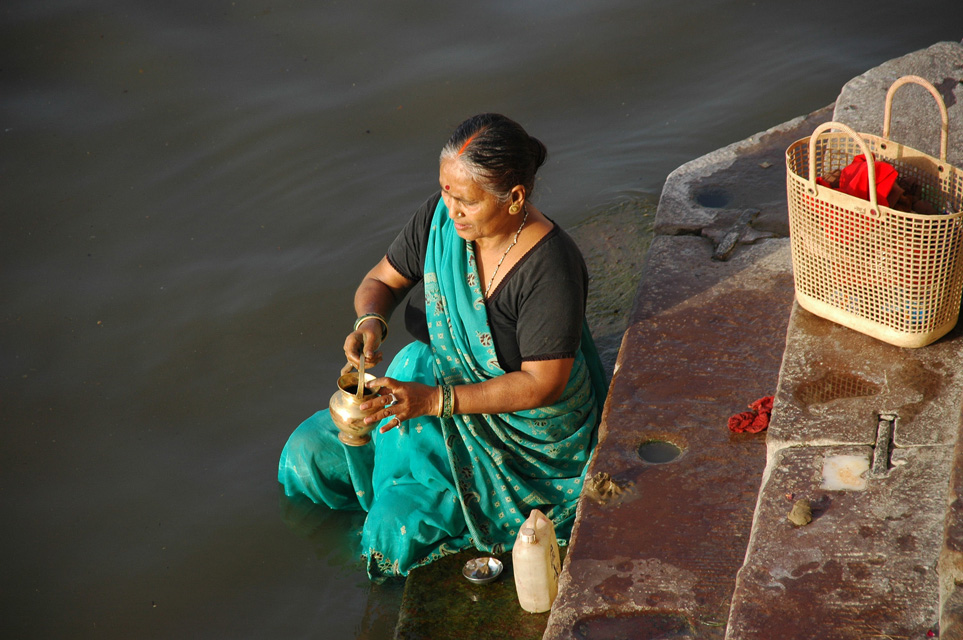
Woman preparing to disperse ashes of a cremated body in the holy Ganges river
15. Death Beads of South Korea
 In South Korea, a law passed in 2000 requires anyone burying a loved one to remove the grave after 60 years. Because of dwindling graveyard space and this resulting law, cremation has become much more popular. But families don’t always opt for ashes. Several companies there compress remains into gem-like beads in turquoise, pink or black. These “death beads” are then displayed in the home.
In South Korea, a law passed in 2000 requires anyone burying a loved one to remove the grave after 60 years. Because of dwindling graveyard space and this resulting law, cremation has become much more popular. But families don’t always opt for ashes. Several companies there compress remains into gem-like beads in turquoise, pink or black. These “death beads” are then displayed in the home.
16. Filipino death traditions
Many ethnic groups in the Philippines have unique funeral practices. The Benguet of Northwestern Philippines blindfold their dead and place them next to the main entrance of the house; their Tinguian neighbors dress bodies in their best clothes, sit them on a chair and place a lit cigarette in their lips.

The Caviteño, who live near Manila, bury their dead in a hollowed-out tree trunk. When someone becomes ill, they select the tree where they will eventually be entombed. Meanwhile, the Apayo, who live in the north, bury their dead under the kitchen.
17. Green funerals
In the United States, more and more people are opting for environmentally friendly burials. This means skipping embalming processes, nixing traditional concrete vaults and getting biodegradable, woven-willow caskets, which decompose into the ground. The Green Burial Council has approved 40 environmentally friendly cemeteries in the U.S. — way up from a decade ago. Another option: becoming a memorial “reef ball.” A company called Eternal Reefs compresses remains into a sphere that is attached to a reef in the ocean, providing a habitat for sea life.

18.Skull Burial – Kiribati

On the tiny island of Kiribati,an island nation in the central tropical Pacific Ocean,the deceased is laid out in their house for [3 to 12 days before burial)… Several months after [the burial, the body is dug up] and the skull removed, oiled, polished, and offered tobacco and food…. the remainder of the body is [reburied and the] islanders keep the skull on a shelf in their home …
19. Lumiang Burial Cave and Hanging Coffins in Sagada, Philippines
The amazing burial cave and hanged coffins of Sagada, where most tourists visit here because of its spectacular way of burying dead people.
There are two ways of burying a coffin, one is by hanging it in the cliffs. Igorots believe that the soul must be in the most peaceful and most solemn place so that the spirit will find its way to their God called “Kabunian”.
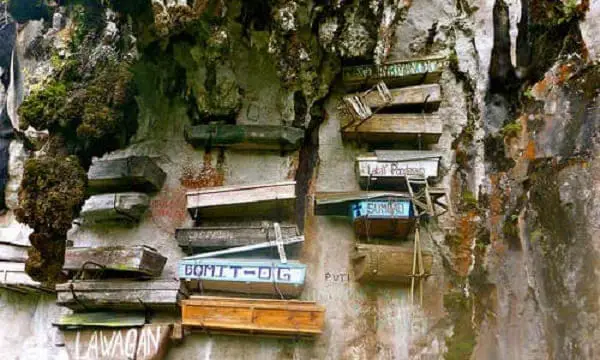
Echo Valley, Sagada, Philippines
The other is by putting it in the cave or known as the Lumiang burial cave. They say when someone gets old they make their own coffin, and when they die they will gonna be buried by their relatives. Because Igorots love their dead ancestor they will put him to the higher part of the cave away to the hungry animals that will roam around the cave.

Lumiang Cave, Philippines
To bury a dead person first, in the morning they will put the coffin to the higher place then in the afternoon they will gonna put the body.
In 1986 the act of burying dead people here has been stopped due to the tourists that goes in here.
It’s so very creepy in here, so don’t go without an accompaniment.
20. Hawaii Cave Burial
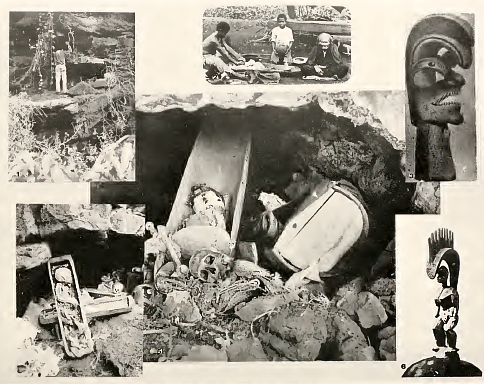
Typical Hawaiian burial cave. The common people after death were usually secreted in caves in the neighborhood; the burial took place during the night.
In Hawaii, burial caves have been found on every island. In some, the deceased were bound in the fetal position. It was believed that the bones of the dead hold great mana, or divine power. It became common to hunt for burial caves to find treasure left with the bodies, leaving few sites intact for researchers.

Tyrone Young visits a burial cave in a lava tube on Hawaii
21. Maasai Leave Remains to Predators

The Maasai are a nomadic tribe located in Kenya and norther Tanzania in Africa. They are one of the better known African tribes, numbering over a million in population. They live close to many East African game parks and offer visits to tourists.
The Maasai people have their own ideas about death primarily due to the high mortality rate in infants and the high risk of disease in tribal life. Babies are not recognized until the age of 3 moons (3 months). The life they lead is almost entirely without ceremony, so the dead are left out for scavengers. Any body not picked up by scavengers is considered a bad omen so the families often coat the body in blood or fat to make it more enticing.
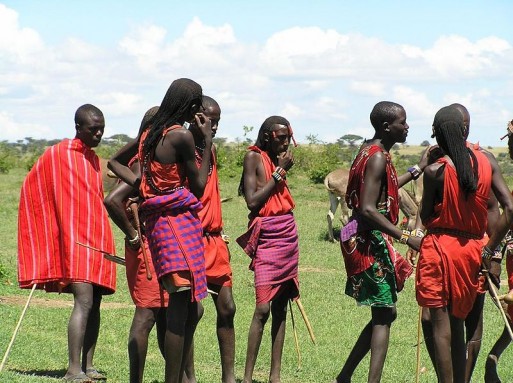
Maasai warriors in traditional clothing
Burial is typically reserved for great chiefs, since it is believed to be harmful to the land, although the increasing number of Christians and Muslims in the Maasai population may lead to traditional burials occurring more often.
22. Haiti Death Practices
The country of Haiti observes death with elaborate ceremony. When a loved one is dying, his or her family will gather to pray, cry, and use religious medallions or other spiritual artifacts. The oldest family member makes all the arrangements and notifications. The body is kept until the entire family can gather. Organ donation or cremation is not even an option, as the whole body is thought to be necessary for resurrection. Autopsies are occasionally performed, sometimes to ensure that the body is actually dead and not a zombie (A voodoo curse commonly believed in rural Haiti).
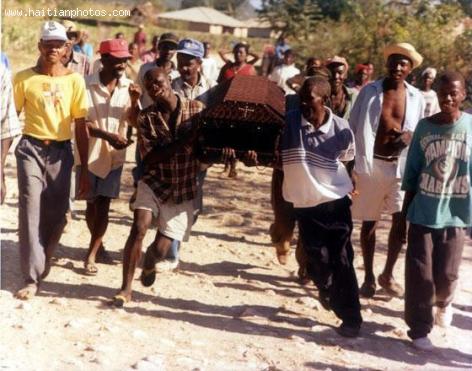
After the person’s demise, Demier priye, a 9-day prayer ritual, is performed. Family, friends, and even enemies of the deceased gather to pray, chant, eat, and drink together. The Prise de deuil takes places on the 9th day (similar to a funeral). Interestingly, the Haitians graveyards are comprised of mausoleums, which make the cemeteries look like miniature villages made of concrete. To get the cash for this construction, the bereaved often have to sell some of their land.
After the devastating earthquake in Haiti, the number of dead was estimated to be as high as 200,000. This made their normal funeral traditions impossible. Most of the bodies were hauled to mass graves, and many bodies are still lying under fallen buildings. Many are still missing.
23. Burial at Sea
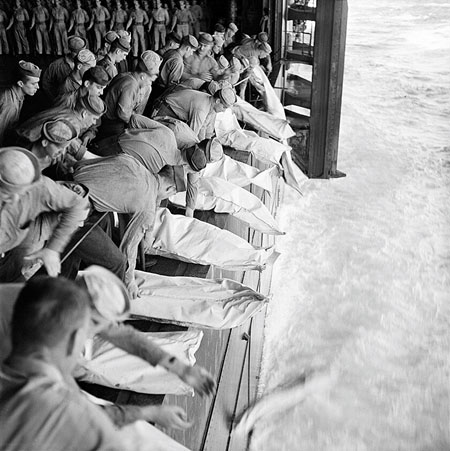
Burial at sea for the officers and men of the USS Intrepid (CV-11) who lost their lives when the carrier was hit by Japanese bombs during operations in the Philippines, Nov. 26, 1944. Credit: Barrett Gallagher
Throughout history, many travelers from all over the world have been buried at sea. The U.S. Navy website states, “In earlier times, the body was sewn into a weighted shroud, usually sailcloth.” Royal W. Connell, William P. Mack write in their book, “Naval Ceremonies, Customs, and Traditions,” that the shroud was sewn up by a sailmaker or one of the deceased’s mates. “The sailmaker, when sewing the canvas shroud, takes the last stitch through the nose of the deceased.”
The body is weighted so it will sink to the bottom. The deceased is then laid at rest in “Davy Jones’ Locker,” which is slang for the bottom of the sea.
24. The First People Flower
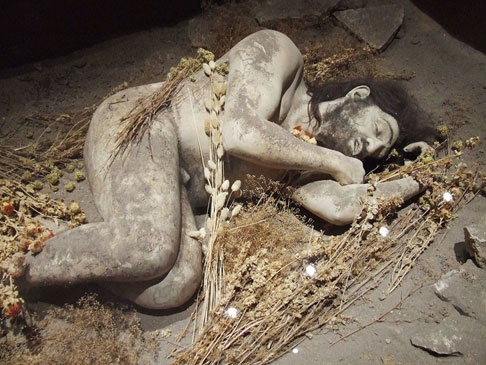
Kebara Cave burial Image: Wikimedia Creative Commons
Flowers were left on Neanderthal graves 65,000 to 35,000 years ago. Anthropologist Ralph Solecki of Columbia University unearthed the fossils in the 1950s and was amazed to find tenderness among the Neanderthals—not only flowers left on graves, but also serious injuries and illnesses that had been tended to and healed. The site, located in northern Iraq, became known as the Shanidar cave. Solecki was inspired to write a book titled “Shanidar: The First Flower People.”
25. Mortuary Totem Poles
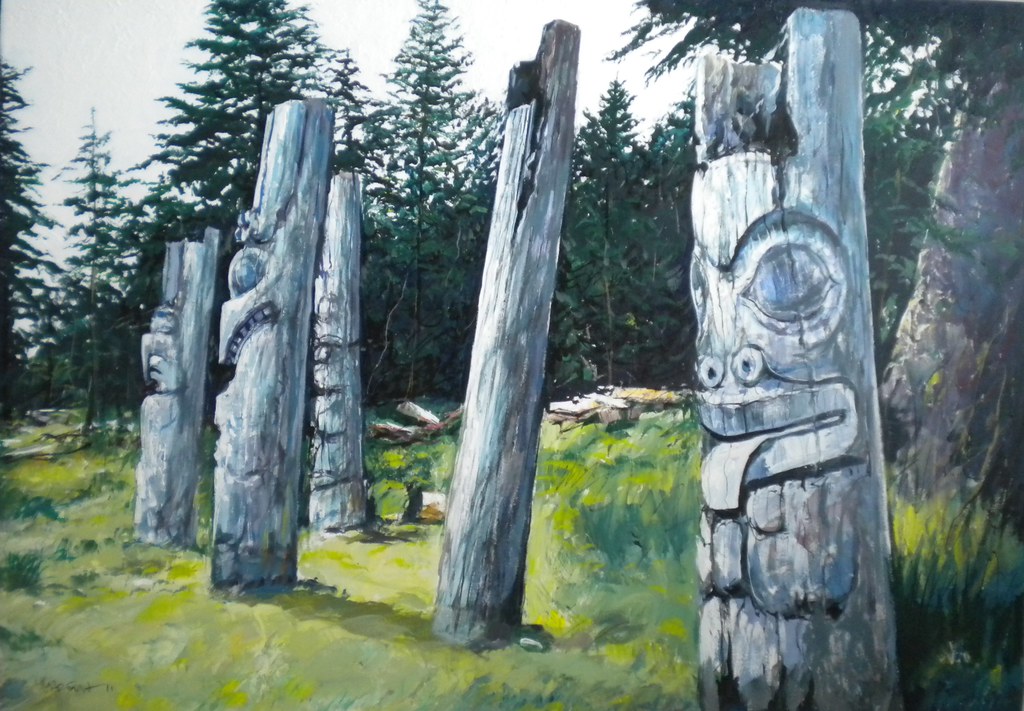
In a hauntingly beautiful mortuary in Gwaii Haanas National Park, totem poles are left to return to their natural state.
Totem poles are used to tell the stories of important aspects of native culture, but there’s one totem that goes beyond even that. The Mortuary Totem Pole is a special type of totem that, though decorated in beautiful carvings that tell a story, has a little something extra added to it. In a little groove carved at the top of the pole would sit the remains of a chief, shaman, or notable warrior. To get the body to fit into the small boxes placed in the groove, it would be crushed to a pulp with clubs. The icons in these poles were meant to act as guardians to guide the spirit to the afterlife. Those that did not receive this treatment were simply thrown into a mass pit where animals would scavenge their bodies.
http://www.sfu.ca/brc/art_architecture/totem_poles.html
Credit link: http://cloudmind.info/25-unusual-death-rituals-from-around-the-world/Sources:


